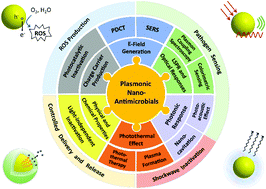Plasmonic nano-antimicrobials: properties, mechanisms and applications in microbe inactivation and sensing†
Abstract
Bacterial, viral and fungal infections pose serious threats to human health and well-being. The continuous emergence of acute infectious diseases caused by pathogenic microbes and the rapid development of resistances against conventional antimicrobial drugs necessitates the development of new and effective strategies for the safe elimination of microbes in water, food or on surfaces, as well as for the inactivation of pathogenic microbes in human hosts. The need for new antimicrobials has triggered the development of plasmonic nano-antimicrobials that facilitate both light-dependent and -independent microbe inactivation mechanisms. This review introduces the relevant photophysical mechanisms underlying these plasmonic nano-antimicrobials, and provides an overview of how the photoresponses and materials properties of plasmonic nanostructures can be applied in microbial pathogen inactivation and sensing applications. Through a systematic analysis of the inactivation efficacies of different plasmonic nanostructures, this review outlines the current state-of-the-art in plasmonic nano-antimicrobials and defines the application space for different microbial inactivation strategies. The advantageous optical properties of plasmonic nano-antimicrobials also enhance microbial detection and sensing modalities and thus help to avoid exposure to microbial pathogens. Sensitive and fast plasmonic microbial sensing modalities and their theranostic and targeted therapeutic applications are discussed.

- This article is part of the themed collection: Recent Review Articles


 Please wait while we load your content...
Please wait while we load your content...